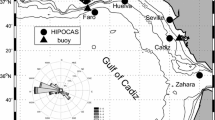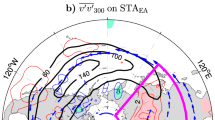Abstract
This study analyzes extremes of geostrophic wind speeds derived from sub-daily surface pressure observations at 13 sites in the European region from the Iberian peninsula to Scandinavia for the period from 1878 or later to 2007. It extends previous studies on storminess conditions in the Northeast (NE) Atlantic-European region. It also briefly discusses the relationship between storminess and the North Atlantic Oscillation (NAO). The results show that storminess conditions in the region from the Northeast Atlantic to western Europe have undergone substantial decadal or longer time scale fluctuations, with considerable seasonal and regional differences (especially between winter and summer, and between the British Isles-North Sea area and other parts of the region). In the North Sea and the Alps areas, there has been a notable increase in the occurrence frequency of strong geostrophic winds from the mid to the late twentieth century. The results also show that, in the cold season (December–March), the NAO-storminess relationship is significantly positive in the north-central part of this region, but negative in the south-southeastern part.








Similar content being viewed by others
Reference
Alexander LV, Tett SFB (2005) Recent observed changes in severe storms over the United Kingdom and Iceland. Geophys Res Lett 32:L13704. doi:10.1029/2005GL022371
Alexandersson H, Tuomenvirta H, Schmith T, Iden K (2000) Trends of storms in NW Europe derived from an updated pressure data set. Clim Res 14:71–73
Alexandersson H, Schmith T, Iden K, Tuomenvirta H (1998) Long-term variations of the storm climate over NW Europe. Glob Atmos Ocean Syst 6:97–120
Allan R, Tett S, Alexander LV (2009) Fluctuations of autumn-winter severe storms over the British Isles: 1920 to present. Int J Climatol 29:357–371. doi:10.1002/joc.1765
Chang EKM (2009) Are band-pass variance statistics useful measures of storm track activity? Re-examining storm track variability associated with the NAO using multiple storm track measures. Clim Dyn 33:277–296. doi:10.1007/s00382-009-0532-9
Compo GP, Sardeshmukh PD (2004) Storm track predictability on seasonal and decadal scales. J Clim 17:3701–3720
Compo GP et al (2011) The twentieth century reanalysis project. Q J R Meteorol Soc 137:1–28
Della-Marta PM, Pinto JG (2009) Statistical uncertainty of changes in winter storms over the North Atlantic and Europe in an ensemble of transient climate simulations. Geophys Res Lett 36:L14703. doi:10.1029/2009GL038557
Dickson RR et al (2000) The Arctic Ocean response to the North Atlantic oscillation. J Clim 13:2671–2696
Folland CK, Knight J, Linderholm HW, Fereday D, Ineson S, Hurrell JW (2009) The summer North Atlantic oscillation: past, present, and future. J Clim 22:1082–1103. doi:10.1175/2008JCLI2459.1
Fowler HJ, Kilsby CG (2003) Implications of changes in seasonal and annual extreme rainfall. Geophys Res Lett 30:1720. doi:10.1029/2003017327
Fowler HJ, Kilsby CG (2003) A regional frequency analysis of United Kingdom extreme rainfall from 1961 to 2000. Int J Climatol 23:1313–1334
Gulev SK, Grigorieva V (2006) Variability of the winter wind waves and swell in the North Atlantic and North Pacific as revealed by the voluntary observing ship data. J Clim 19:5667–5785
Gulev SK, Grigorieva V (2004) Last century changes in ocean wind wave height from global visual wave data. Geophys Res Lett 31:L24302. doi:10.1029/2004GL021040
Gulev SK, Zolina O, Grigoriev S (2001) Extratropical cyclone variability in the Northern Hemisphere winter from the NNRs/NCAR reanalysis data. Clim Dyn 17:795–809
Hurrell JW (1995) Decadal trends in the North Atlantic oscillation: regional temperatures and precipitation. Science 269:676–679
Hurrell JW, van Loon H (1997) Decadal variations associated with the North Atlantic oscillation. Clim Change 36:301–326
Ihara C, Kushner Y (2009) Change of mean mid-latitude westerlies in the 21st century climate simulations. Geophys Res Lett 36:L13701. doi:10.1029/2009GL037674
IPCC (2007) Summary for policymakers. In: Solomon S et al (eds) Climate change 2007: the physical science basis. Contribution of working group I to the fourth assessment report of the intergovernmental panel on climate change. Cambridge University Press, Cambridge, UK and New York, USA, 944 pp
Jung T, Hilmer M, Ruprecht E, Kleppek S, Gulev SK, Zolina O (2003) Characteristics of the recent eastward shift of interannual NAO variability. J Clim 16:3371–3382
Kushner PJ, Held IM, Delworth TL (2001) Southern Hemisphere atmospheric circulation response to global warming. J Clim 14:2238–2249
Lambert S, Fyfe JC (2006) Changes in winter cyclone frequencies and strengths simulated in enhanced greenhouse gas experiments: results from the models participating in the IPCC diagnostic exercise. Clim Dyn 26:713–728. doi:10.1007/s00382-006-0110-3
Leckebusch GC, Koffi B, Ulbrich U, Pinto JG, Spangehl T, Zacharias S (2006) Analysis of frequency and intensity of winter storm events in Europe on synoptic and regional scales from a multi-model perspective. Clim Res 31:59–74
Livezey RE, Chen WY (1983) Statistical field significance and its determination by Monte Carlo techniques. Mon Weather Rev 111:46–59
Loeptien U, Zolina O, Gulev S, Latif M, Soloviov V (2008) Cyclone life cycle characteristics over the Northern Hemisphere in coupled GCMs. Clim Dyn 31:507–532. doi:10.1007/s00382-007-0355-5
Lorenz DJ, DeWeaver ET (2007) Tropopause height and zonal wind response to global warming in the IPCC scenario integrations. J Geophys Res 112:D10119. doi:10.1029/2006JD008087
Madden RA, Jones RH (2001) A quantitative estimate of the effect of aliasing in climatological time series. J Clim 14:3987–3993
Matulla C, Schoener W, Alexandersson H, von Stroch H, Wang XL (2008) European storminess: late nineteenth century to present. Clim Dyn 31:125–130. doi:10.1007/s00382-007-0333-y
McCabe GJ, Clark MP, Serreze MC (2001) Trends in Northern Hemisphere surface cyclone frequency and intensity. J Clim 14:2763–2768
Meehl GA et al (2007) Global climate projections. In: Solomon S et al (eds) Climate change 2007: the physical science basis. Contribution of working group I to the fourth assessment report of the intergovernmental panel on climate change. Cambridge University Press, Cambridge, UK and New York, USA, 944 pp
Portis DH, Walsh JE, Hamly ME, Lamb PJ (2001) Seasonality of the North Atlantic oscillation. J Clim 14:2069–2078
Schinke H (1993) On the occurrence of deep cyclones over Europe and the North Atlantic in the period 1930–1991. Contrib Atmos Phys 66(3):223–237
Schmidt H, von Storch H (1993) German Bight storms analyzed. Nature 365:791
Serreze MC, Carse F, Barry RG, Rogers JC (1997) Icelandic low cyclone activity: climatological features, linkages with the NAO, and relationships with recent changes in the Northern Hemisphere circulation. J Clim 10(3):453–464
Solomon S et al (2007) Technical summary. In: Solomon S et al (eds) Climate change 2007: the physical science basis. Contribution of working group I to the fourth assessment report of the intergovernmental panel on climate change. Cambridge University Press, Cambridge, UK and New York, USA, 944 pp
Sweeney J (2000) A three-century storm climatology for Dublin 1715–2000. Irish Geogr 33(1):1–14
Trenberth KE et al (2007) Observations: surface and atmospheric climate change. In: Solomon S et al (eds) Climate change 2007: the physical science basis. Contribution of working group I to the fourth assessment report of the intergovernmental panel on climate change. Cambridge University Press, Cambridge, UK and New York, USA, 944 pp
Ulbrich U, Leckebusch GC, Pinto JG (2009) Extra-tropical cyclones in the present and future climate: a review. Theor Appl Climatol 96:117–131. doi:10.1007/s00704-008-0083-8
Ulbrich U, Christoph M (1999) A shift of the NAO and increasing storm track activity over Europe due to anthropogenic greenhouse gas forcing. Clim Dyn 15:551–559
von Storch H et al (1993) Changing statistics of storms in the North Atlantic. MPI report 116, Hamburg, 23 pp
Wallace JM, Gutzler DS (1981) Teleconnections in the peopotential height field during the Northern Hemisphere winter. Mon Weather Rev 109:784–812
Wang XLL, Zwiers FW, Swail VR, Feng Y (2009) Trends and variability of storminess in the Northeast Atlantic region, 1874–2007. Clim Dyn 33:1179–1195. doi:10.1007/s00382-008-0504-5
Wang XL, Swail VR, Zwiers FW, Zhang X, Feng Y (2008) Detection of external influence on trends of atmospheric storminess and ocean wave heights. Clim Dyn 32:189–203. doi:10.1007/s00382-008-0442-2
Wang XLL, Swail VR (2006) Historical and possible future changes of wave heights in northern hemisphere oceans. Atmos Ocean Interact 2. In: Perrie W (ed) Advances in fluid mechanics series, vol 39. Wessex Institute of Technology Press, Southampton, 240 pp
Wang XLL, Swail VR, Zwiers FW (2006) Climatology and changes of extra-tropical cyclone activity: comparison of ERA-40 with NCEP/NCAR reanalysis for 1958–2001. J Clim 19:3145–3166. doi:10.1175/JCLI3781.1
Wang XLL, Wan H, Swail VR (2006) Observed changes in cyclone activity in Canada and their relationships to major circulation regimes. J Clim 19(6):896–915. doi:10.1175/JCLI3664.1
Wilks DS (2006) On “Field Significance” and the false discovery rate. J Appl Meteorol Climatol 45:1181–1189. doi:10.1175/JAM2404.1
Yin X, Gleason, BE, Vose RS, Compo GP, Matsui N (2008) The International Surface Pressure Databank (ISPD) Version 2.2. National Climatic Data Center, Asheville, pp 1–12. Accessible at ftp://ftp.ncdc.noaa.gov/pub/data/ispd/doc/ISPD2_2.pdf
Acknowledgments
The authors are very grateful to all members of GCOS/WCRP AOPC/OOPC (Atmosphere/Ocean Observation Panel for Climate) Working Group on Surface Pressure for providing us with access to the International Surface Pressure Databank, which includes almost all the pressure data we analyzed in this study. Dr. José Antonio López of the Spanish State Meteorological Agency is also acknowledged for providing extra data to fill in data gaps in the records of two Spanish stations in the ISPD. Rob Allan is primarily funded as Program Manager of the international Atmospheric Circulation Reconstructions over the Earth (ACRE) initiative by the Queensland Climate Change Centre of Excellence (QCCCE) in Australia, with some additional funds from the UK Joint Department of Energy and Climate Change (DECC) and Department for Environment, Food and Rural Affairs (Defra) Integrated Climate Programme, DECC/Defra (GA01101). The authors also wish to thank Drs. Xuebin Zhang and Seung-Ki Min for their useful internal review of an earlier version of this manuscript, and the two anonymous reviewers for their helpful review comments.
Author information
Authors and Affiliations
Corresponding author
Appendix: Data quality control and interpolation procedures
Appendix: Data quality control and interpolation procedures
As in W09, a site in this study also refers to the combination of two or more stations that are very close to each other; and each SLP data series is also first screened for large random errors and then interpolated in time, using a natural spline fit, to ensure that the three sites that form a triangle have SLP values for the same hours (see W09 for more details). The screening for large random errors is done by checking if the pressure tendency lies within pre-set limits and comparing the segment of SLP observation with the corresponding segment of observations at the available nearest stations (see Appendix A in W09 for details). Table 4 lists the erroneous/suspicious SLP values identified for the 9 sites that were not previously analyzed (sites 1–9 in Table 1). Note that the general characteristics of the decadal or longer time scale storminess variability are not significantly affected by the correction or exclusion of these erroneous/suspicious SLP values, which, however, does make a few outliers disappear.
Rights and permissions
About this article
Cite this article
Wang, X.L., Wan, H., Zwiers, F.W. et al. Trends and low-frequency variability of storminess over western Europe, 1878–2007. Clim Dyn 37, 2355–2371 (2011). https://doi.org/10.1007/s00382-011-1107-0
Received:
Accepted:
Published:
Issue Date:
DOI: https://doi.org/10.1007/s00382-011-1107-0




